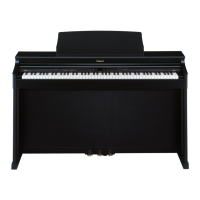Roland Corporation US page 2
Exploring the HP-203
5. Using sounds together – DUAL PLAY (this enables you to play two tones at the same time
across the entire keyboard and is also referred to as ‘layering’.) [OM page 33]
a. Press two tone buttons simultaneously.
b. NOTE: Of the two selected tone buttons, the one on the left is called ‘TONE 1’ and the
one to the right is called ‘TONE 2’.
c. To change the tone assigned to the TONE 1 button, use the -/+ buttons.
d. To change the tone assigned to the TONE 2 button, hold the button down and while
holding the button down use the -/+ buttons to change its selected tone.
e. NOTE: You may change the volume balance of TONE 1 and TONE 2.
i. While holding the TRANSPOSE button down, touch the SPLIT button.
ii. The display will show the volume of each tone, the number on the left represents
the volume of TONE 1 and the number on the right represents the volume of
TONE 2.
iii. Use the -/+ buttons to change the balance.
iv. Press either the TRANSPOSE or SPLIT button to return the display to show the
selected tone.
f. To turn DUAL PLAY off, simply push any tone button.
6. DIVERSION back to orchestration/arranging class
a. Solo instruments vs. ensemble instruments
b. What kind of ‘mood’ are we trying to create?
c. Back to the importance of exploring ALL the tones. (sounds, voices)
d. Suggested possibilities
i. Piano with Strings
ii. Piano with Choir
iii. EP Piano with Strings
7. Using sounds together – SPLIT PLAY (this splits the keyboard and allows you to have one tone
in the right hand, and a different tone in the left hand.) [OM page 35]
a. Choose the tone desired for the right hand (using our new-found knowledge)
b. Press the SPLIT button. (to the left of the Tone buttons)
c. To change the tone assigned to the left hand . . . while holding the SPLIT button down
touch the tone family button of the desired tone then use the -/+ buttons to select the
specific tone.
d. NOTE: During SPLIT PLAY the right hand tone is referred to as TONE 1 and the tone
assigned to the left hand is referred to as TONE 2.
e. NOTE: During SPLIT PLAY the damper pedal can be applied to both tones, or to just
one of the tones.
i. While holding down the BRILLIANCE button, press the 3D button. This allows us
to access various FUNCTIONS and the display will indicate “Fnc”.
ii. Now touch the TWIN PIANO button. The display will indicate “dPr”. (If the
display does not indicate “dPr”, hold down the TWIN PIANO button and while
holding it down use the -/+ buttons to change the display until it does indicate
“dPr”)

